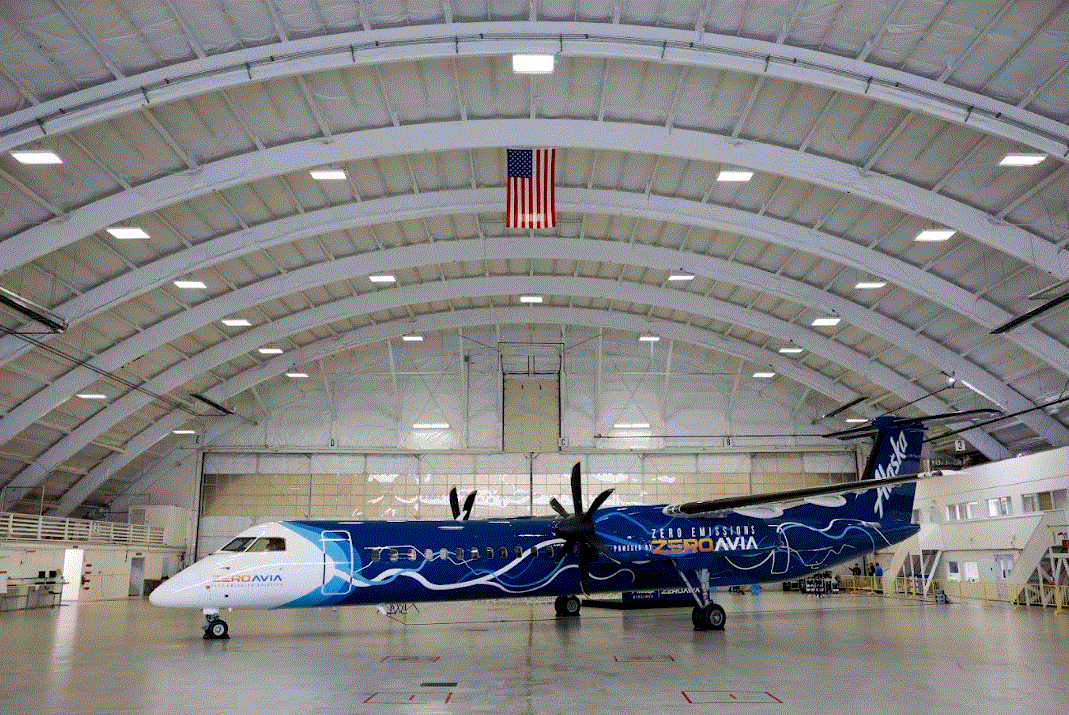
Alaska Airlines has handed over a Dash 8 Q400 regional turboprop to ZeroAvia, to be retrofitted with a hydrogen-electric propulsion system.
According to a joint company press release: “When Alaska Airlines’ regional carrier Horizon Air retired its Q400 fleet, it reserved one of the aircraft for research and development purposes to further advance zero emissions technology for the aviation industry. The aircraft was repainted with a special livery to highlight the innovative mission of this partnership.
“ZeroAvia also debuted its breakthrough multi-megawatt modular electric motor system in a 1.8MW prototype configuration at the event – demonstrated with a propeller spin aboard the ZeroAvia’s 15-ton HyperTruck ground-test rig. Combined with higher temperature PEM fuel cells and advanced power electronics – both technologies that ZeroAvia is developing in-house – the leading-edge electric motor technology is one of three key building blocks for enabling commercially-relevant hydrogen fuel cell engines for larger aircraft. … Aligning ZeroAvia’s powertrain with the Dash 8-400 airframe will represent a commercially viable zero-emission aircraft with fuel cell engine technology around five times more powerful than what has been demonstrated anywhere to date.”
“This is a great step forward in aviation innovation, to help create a new future of flight – right here at home,” said Alaska Airlines CEO Ben Minicucci. “Alaska Airlines has defined a five-part journey to achieve net zero carbon emissions long-term, but we can’t get there alone. New technologies are required to make that future possible, and we’re thrilled to partner with industry leader ZeroAvia to make new zero emissions options a reality.”
“Demonstrating this size of aircraft in flight, powered entirely by novel propulsion, would have been unthinkable a few years ago,” said Val Miftakhov, founder and CEO of ZeroAvia. “Launching this program puts us on track for a test flight next year, and accelerates our progress toward the future of zero-emission flight for Alaska Airlines and for the world at large.”
ZeroAvia’s hydrogen-electric engine uses fuel cells to generate electricity from hydrogen fuel, before using that electricity to power electric motors which turn the aircraft propellers. The certifiable ZA2000 system will include ZeroAvia’s High Temperature PEM fuel cells and liquid hydrogen fuel storage, integral to delivering the necessary energy density for commercial operations of large regional turboprops. The company has already established an engineering partnership with De Havilland of Canada, the original manufacturer of the Dash 8 family of aircraft to enable exchange of data and expertise with the airframe.
In 2021, Alaska Airlines launched a partnership and invested in ZeroAvia to support the development of zero emissions propulsion technology for regional aircraft.
The 1.8MW motor configuration consists of two “HyperCore” motor modules, each a high-power, high-speed 900kW permanent magnet radial flux machine which operates at 20,000 rpm, matching the typical turbine engine power turbine speeds, providing a 15kW/kg motor power density. “Crucially, HyperCore’s modular design enables the technology to address applications ranging from 900kW up to 5.4MW, meeting a number of regional turbo-prop and regional jet requirements,” said the press release. “The HyperCores were successfully integrated with the stock Dash 8-400 engine gearbox and propeller, which dramatically simplifies integration into the aircraft as a replacement for a stock turbine engine. The development and testing program will enable the understanding and measurement of system dynamics, calibration of physical and electrical models, and validation of thermal management systems. The company is concurrently developing world-class silicone-carbide power electronics and the matching hydrogen fuel cell systems, which convert hydrogen to electricity, powering the electric propulsion system. These systems will be brought together to create the full hydrogen-electric propulsion system, tested on the ground and then in the air.”
For more information


